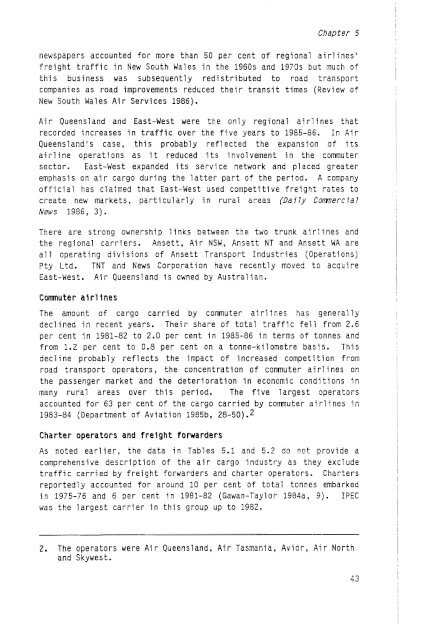Domestic Air Cargo Industry in Australia - Bureau of Infrastructure ...
Domestic Air Cargo Industry in Australia - Bureau of Infrastructure ...
Domestic Air Cargo Industry in Australia - Bureau of Infrastructure ...
Create successful ePaper yourself
Turn your PDF publications into a flip-book with our unique Google optimized e-Paper software.
Chapter 5newspapers accounted for more than 50 per cent <strong>of</strong> regional airl<strong>in</strong>es'freight traffic <strong>in</strong> New South Wales <strong>in</strong> the 1960s and 1970s but much <strong>of</strong>this bus<strong>in</strong>ess was subsequently redistributed to road transportcompanies as road improvements reduced their transit times (Review <strong>of</strong>New South Wales <strong>Air</strong> Services 1986).<strong>Air</strong> Queensland and East-West were the only regional airl<strong>in</strong>es thatrecorded <strong>in</strong>creases <strong>in</strong> traffic over the five years to 1985-86. In <strong>Air</strong>Queensland's case, this probably reflected the expansion <strong>of</strong> itsairl<strong>in</strong>e operations as it reduced its <strong>in</strong>volvement <strong>in</strong> the comnutersector. East-West expanded its service network and placed greateremphasis on air cargo dur<strong>in</strong>g the latter part <strong>of</strong> the period. A company<strong>of</strong>ficial has claimed that East-West used competitive freight rates tocreate new markets, particularly <strong>in</strong> rural areas (Daily ComnercialNews 1986, 3).There are strong ownership 1 <strong>in</strong>ks between the two trunk airl<strong>in</strong>es andthe regional carriers. Ansett, <strong>Air</strong> NSW, Ansett NT and Ansett WA areall operat<strong>in</strong>g divisions <strong>of</strong> Ansett Transport Industries (Operations)Pty Ltd. TNT and News Corporation have recently moved to acquireEast-West. <strong>Air</strong> Queensland is owned by <strong>Australia</strong>n.Comnuter ai rl <strong>in</strong>esThe amount <strong>of</strong> cargo carried by comuter air1 <strong>in</strong>es has generallydecl<strong>in</strong>ed <strong>in</strong> recent years. Their share <strong>of</strong> total traffic fell from 2.6per cent <strong>in</strong> 1981-82 to 2.0 per cent <strong>in</strong> 1985-86 <strong>in</strong> terms <strong>of</strong> tonnes andfrom 1.2 per cent to 0.8 per cent on a tonne-kilometre basis. Thisdecl<strong>in</strong>e probably reflects the impact <strong>of</strong> <strong>in</strong>creased competition fromroad transport operators, the concentration <strong>of</strong> comnuter airl<strong>in</strong>es onthe passenger market and the deterioration <strong>in</strong> economic conditions <strong>in</strong>many rural areas over this period. The five largest operatorsaccounted for 63 per cent <strong>of</strong> the cargo carried by comnuter airl<strong>in</strong>es <strong>in</strong>1983-84 (Department <strong>of</strong> Aviation 1985b, 28-50).2Charter operators and freight forwardersAs noted earlier, the data <strong>in</strong> Tables 5.1 and 5.2 do not provide acomprehensive description <strong>of</strong> the air cargo <strong>in</strong>dustry as they excludetraffic carried by freight forwarders and charter operators. Chartersreportedly accounted for around 10 per cent <strong>of</strong> total tonnes embarked<strong>in</strong> 1975-76 and 6 per cent <strong>in</strong> 1981-82 (Gawan-Taylor 1984a, 9). IPECwas the largest carrier <strong>in</strong> this group up to 1982.2. The operators were <strong>Air</strong> Queensland, <strong>Air</strong> Tasmania, Avior, <strong>Air</strong> Northand Skywest.43
















